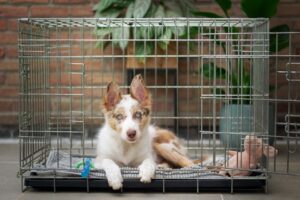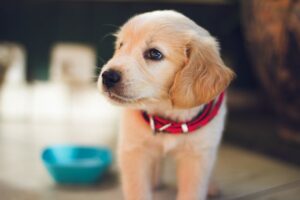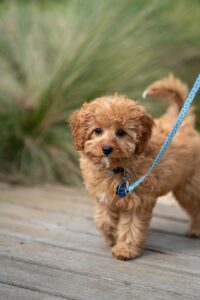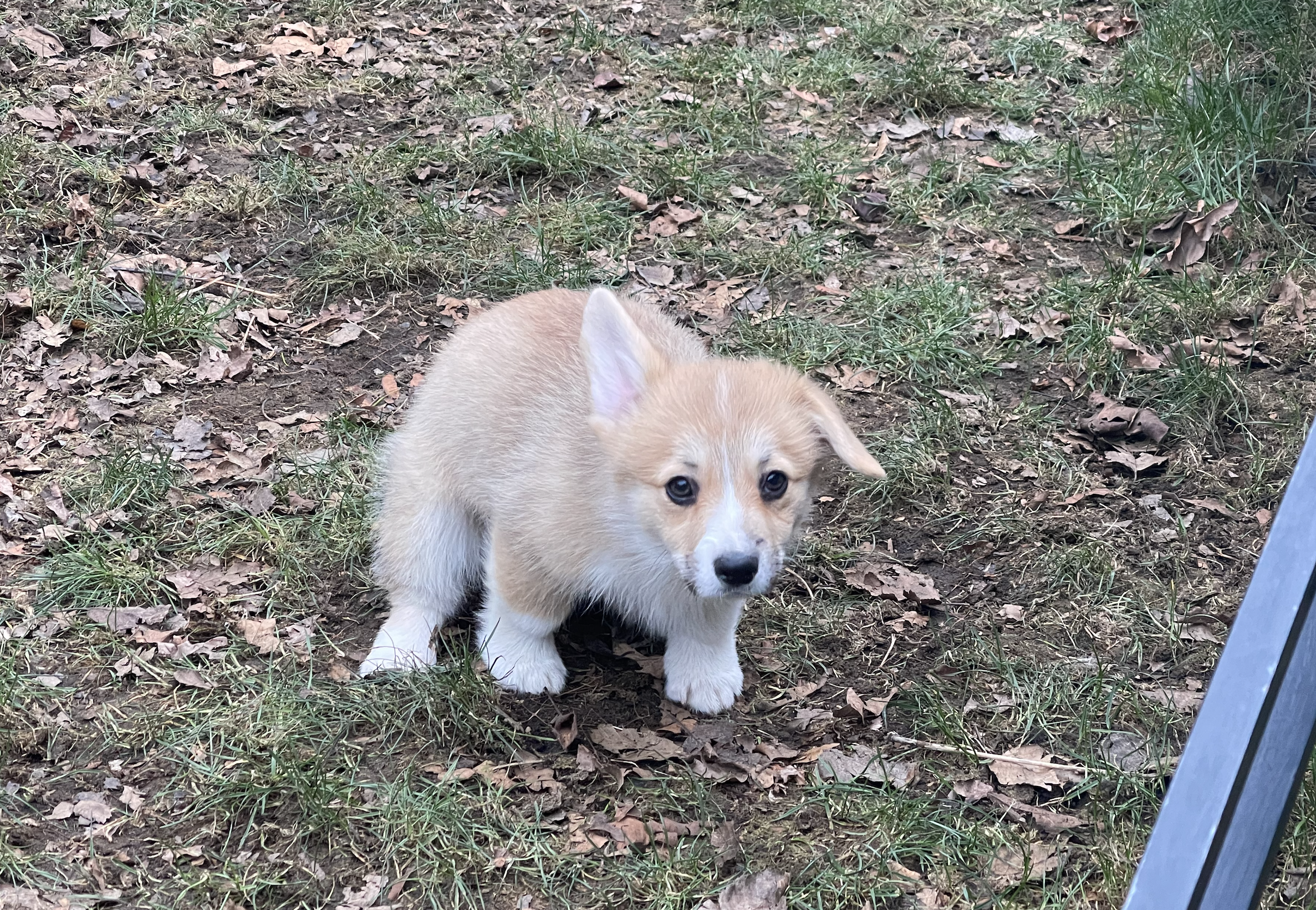The easiest way to make potty training go as smoothly and quickly as possible is to work PROACTIVELY rather than REACTIVELY. This means that, rather than focusing on what to do WHEN our puppies have potty accidents, we need to focus on how to PREVENT our puppies from having potty accidents.
The three pillars of potty training:
Potty training is my least favorite part of puppy raising. Finding and cleaning up accidents is annoying, and remembering to take puppies out regularly can interrupt daily activities. Puppies often don’t understand how to tell when they need to go until it’s too late, how to ask to go outside, or why to bother going outside in the first place when inside is more convenient.
Engagement:
Engagement refers to time spent playing with your puppy, training your puppy, or where your puppy is actively engaged with an “assigned task” such as working on a kong or brain toy. If you notice your pup disengage during this time, especially if she disengages to go sniff around the room, it may be time for a potty break.
Supervision:
Supervision refers to time where your puppy doesn’t have something specific to work on, and is just hanging out with you having some free time. While it can be tempting to multitask here, successful supervision includes eyes on your puppy the whole time she’s out. This will not only help prevent accidents, but also will prevent unwanted chewing of your stuff.
If multiple people are in the room while your puppy is having free time, assign one to be the Puppy Watcher. This will avoid the “I thought you were watching her!” situation in the event that your pup has an accident. The more carefully you watch your pup during free play while she is young, the more quickly she will be able to earn less heavily supervised freedom. The key to building a trustworthy dog is interrupting and redirecting your puppy BEFORE she’s able to practice naughty behaviors as much as possible.
To make supervision easier, only give your pup access to a single room at first. Baby gates and exercise pens are a great way to block access to “forbidden” areas of the house until your pup is ready. Remember, freedom is earned, not a given!
 Confinement:
Confinement:
Engagement and Supervision take a LOT of mental effort for the human half of the puppy raising team. Fortunately, young puppies also need a LOT of sleep! Puppies under 6 months of age typically need around 16-18 hours of sleep per day. That only leaves about 6-8 hours of awake time! Lots of naps in containment zones like crates and exercise pens makes for less tired/cranky puppies, and gives you plenty of time to get errands and chores done.
Training your pup to be ok in her confinement area is important! To help your puppy feel more comfortable in her crate or exercise pen, some strategies include: feeding some meals in her confinement zone, giving long lasting edible chews like beef cheek rolls, making sure your pup is mentally and physically tired before going in her confinement zone, practicing sitting near her confinement zone so she doesn’t feel alone, and experimenting with bedding (or lack thereof) to help your pup be as comfortable as she can be.
For shorter periods (up to 3-4 hours at a time during the day for younger pups), crates are an excellent tool to help pups settle and take a nap. Crates are not recommended to use for longer than 4 hours during the day in a single stretch, as puppies need access to potty as well as room to move, and ideally some degree of interaction from humans. Potty pads in crates can teach puppies that pottying in her crate is ok, which can become a gross habit that is difficult to break.
If you need to leave your pup alone for more than 4 hours, an exercise pen is a better choice (use a lid if your pup is a climber). A fake grass patch or litter tray are both excellent alternatives to traditional potty pads, which are easy and fun (and gross) for puppies to tear up, and can teach pups that pottying on soft surfaces, such as carpet or blankets, is a good choice.
How often should your puppy go outside?
When I bring a new puppy home, I typically take them out every 15-20 minutes while they’re awake and active for the first few weeks. Is that excessive? Possibly, but I want to give my puppy every opportunity possible to make the correct choice, and ideally prevent wrong choices. When your puppy goes potty outside, celebrate! You can give treats, or you can just play and verbally/physically praise her.
As your pup is successfully pottying as soon as she goes out, and isn’t having accidents inside, you can gradually move towards letting her out every 20-30 minutes, then 30-40 minutes, and so on. The goal is no accidents at all before increasing the time between outdoor trips.
Regression in potty training is normal – if your puppy has been fine for a while and then seems to suddenly forgets her potty training, don’t fret! Just go back a few steps until your pup is successful again, and then work back up to where you were. Puppy raising and potty training is a marathon, not a sprint. Remember that you’re building your pup into the companion you will get to enjoy for the next 10-15 years, so spending a bit of extra time and effort in the first few months goes a LONG way towards setting her up for years of success.

Teaching your pup to give a potty signal:
There are two main options to teaching your pup to give a signal that she needs to go outside:
- A trained signal (such as Bell Training): First, teach your puppy to ring a bell as a trick. Hold the bell in front of her, and any time your puppy noses or paws at the bell, mark with a verbal “yes!” and give your pup a treat. Next, practice the same thing while dangling the bell rather than holding it. Then, practice with the bell hung on the door. When your pup is ringing the bell on her own expecting treats, switch the meaning to become: puppy rings bell, puppy goes outside, puppy gets a treat AFTER she potties. Bell training is excellent for households where the outside door is not visible from the entire house.
- A natural signal (such as sitting by the door): While supervising your puppy, keep an eye out for any time she walks within 10 feet of the outside door. When this happens, take her outside for a few minutes, whether you think she has to go or not, and celebrate if she goes potty. After a few days of this, switch to taking her out when she goes within 5 feet of the door, then 3 feet, until she’s going right up to the door and waiting near it. Sitting by the door is a more easily generalized skill, meaning your pup will be have an easier time finding doors to wait near at home, when visiting friends’ houses, when traveling, and more.
What to do if you find an accident:
If an accident has already happened, clean it up with an enzymatic cleaner, make a note of the situation and try to prevent it next time. Do not get upset with your puppy or punish her – it won’t prevent an accident in the future and may make your puppy afraid to go to the bathroom in front of you (which is super inconvenient for leash walks), or may just teach them to hide their accidents inside.
If your pup won’t go outside and then goes immediately once she’s inside:
This is a pretty common challenge for puppies! The great outdoors can be very distracting, while inside where pups spend most of their time can be much more boring, which is when a lot of pups remember to go potty. If you find your pup is doing this, follow the 5-20-5 rule:
- 5 minutes outside, on leash – if your puppy potties during this time, awesome! Praise, celebrate, and let her off leash if safe. If your pup does not potty during this time, pick her up, carry her inside, and place her directly into her confinement area.
- 20 minutes in confinement area – this isn’t a punishment, it’s management to prevent your pup from accessing the house to have an accident. After 20 minutes, put your pup back on leash, carry her back out, and repeat for another 5 minutes outside. Repeat this cycle until your puppy goes to the bathroom outside.
 Common mistakes:
Common mistakes:
Some common puppy potty training mistakes include:
- Too much freedom, too fast – a few days of potty training success or a busy schedule can make it tempting to let puppies have lots of freedom early on. Unsupervised puppies typically don’t make the best choices, including finding secret spots for accidents, chewing up your things, or looking for other trouble to get into. Stay consistent about the three pillars until your pup is routinely asking you to go out as needed and having ZERO accidents in the house will give you your best chance at success.
- Not practicing on leash – especially if you’re spending most of your time with your pup at home, it can be tempting to just let her off leash in the yard to potty. Practicing off leash AND on leash are both important skills to ensure she knows how to do her business whether at home or on the go.
- Potty pad woes – potty pads can seem like an easy way to save the house from mess. Much of the time though, they just teach puppies to find soft surfaces to use the bathroom on, which can include rugs, blankets, clothes, dog beds, etc. If you need an indoor potty spot for your puppy, a grass patch, mulch patch (such as the BarkPotty), or litter tray can be a great solution. Puppies pay attention to surface types, so encouraging bathroom use on “outdoor” type surfaces translates much more easily to only using the bathroom outside as opposed to traditional potty pads.
- Punishing for accidents – it can be frustrating when puppies have accidents, especially when it happens without warning. However, getting upset with your puppy for having an accident will not prevent an accident in the future, and runs the risk of teaching your pup that going to the bathroom in front of you is scary. This can teach your pup that it’s ok to go inside as long as she hides, or that going to the bathroom in front of you (including on leash) is to be avoided. Keep your puppy’s trust! Take a deep breath when your pup has an accident put them outside or in their containment zone while you clean it up, and try to prevent an accident from happening in a similar situation in the future.
Setting up for success:
Like with many other training skills for puppies, a lot of their progress depends on mental and physical maturity. Even if you’re doing everything correct, some puppies just mature more slowly. Continue setting your pup up for success and doing as much as you can to prevent or minimize accidents, and your pup will catch on when she’s ready.
As with many other behaviors, practice makes perfect. This means that the more your puppy practices going in appropriate places (like outside), and the less they have the opportunity to go to the bathroom inside, the faster your progress will be.


Recent Comments